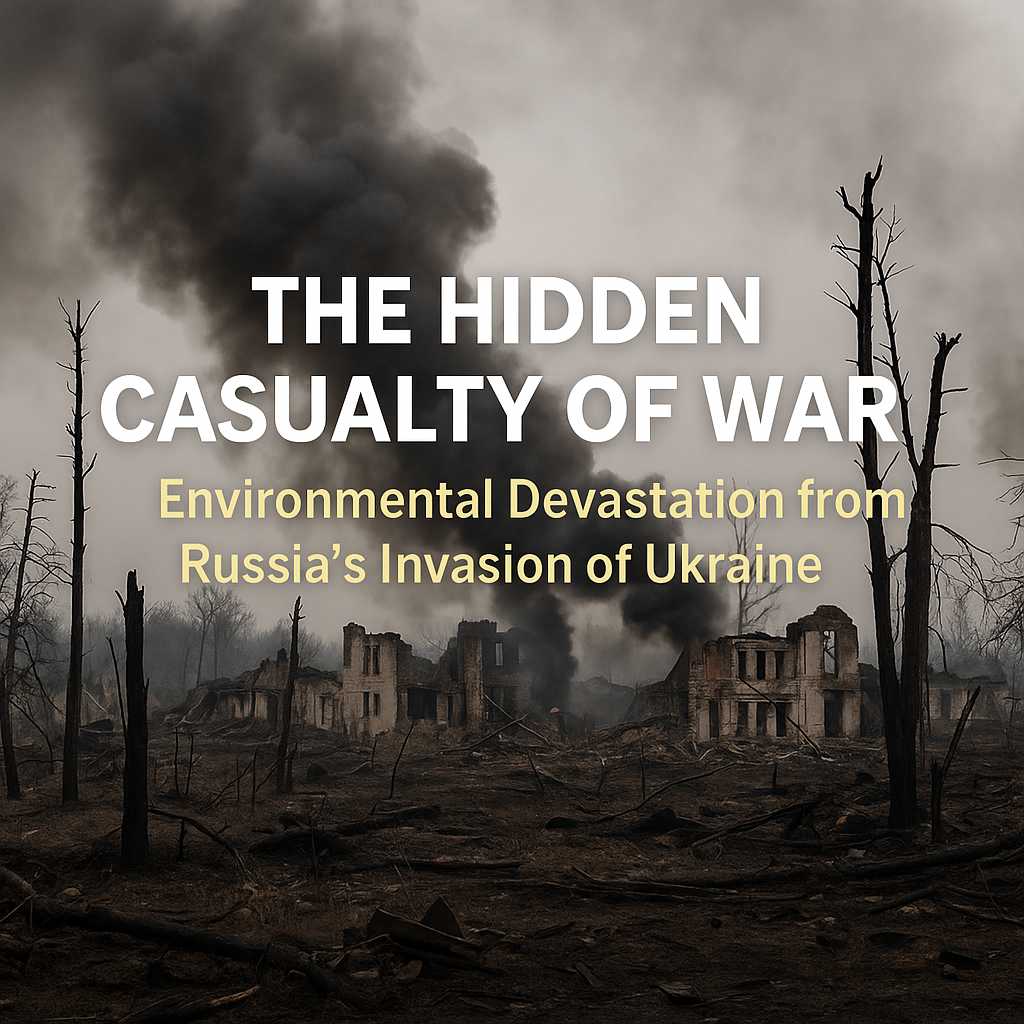When nations go to war, the cost is always greater than what can be measured in human lives alone. The ongoing Russian invasion of Ukraine, now entering its devastating third year, has brought not only humanitarian crises but also catastrophic environmental damage — consequences that may last generations and affect the entire planet.
Carbon Emissions: A War Machine’s Footprint
War machinery is a heavy emitter of carbon dioxide (CO₂). Tanks, jets, troop movements, and bombings have already created a massive carbon footprint across Ukraine. Estimates suggest that in 2022 alone, emissions linked to the conflict surpassed the annual output of entire small countries. Fires set by artillery, the destruction of industrial facilities, and the breakdown of critical infrastructure have created enormous amounts of greenhouse gases, accelerating the very climate change that imperils all humanity.
Toxic Weapons: Depleted Uranium, Lead, and Chemical Fallout
The deployment of depleted uranium (DU) munitions has added a dangerous new layer of toxicity to Ukraine’s landscape. When DU shells strike, they release fine radioactive dust, capable of poisoning soil and air.
Lead contamination from countless rounds of ammunition has entered the environment, putting wildlife, livestock, and humans at risk. In addition, the destruction of chemical plants and storage facilities has triggered uncontrolled chemical releases, filling the air, rivers, and earth with substances known to cause cancers, respiratory disease, and birth defects.
Urban Destruction: Buildings Turned to Toxic Rubble
Each bombed building is not merely a pile of concrete. Modern structures contain asbestos, heavy metals, plastics, and chemical coatings that, when pulverized by explosions, release harmful particulates into the air and soil. Rubble from shattered cities like Mariupol, Kharkiv, and Bakhmut is now a lingering environmental hazard. The dust blown by winds spreads invisible threats to farmlands and water sources alike.
Forests in Flames: A Climate and Biodiversity Disaster
Ukraine’s vast forests, critical for absorbing CO₂ and hosting countless plant and animal species, have been ravaged by shelling, missile strikes, and fires. Once-thriving ecosystems are now charred wastelands. With trees gone, the soil erodes faster, carbon capture is reduced, and once-protected species face extinction. Moreover, these destroyed forests will take decades, if not longer, to naturally recover — if they ever do.
Nuclear Nightmare: The Zaporizhzhia Power Plant Crisis
Perhaps the greatest threat still looming is the precarious situation at the Zaporizhzhia Nuclear Power Plant, Europe’s largest. Ongoing fighting near the facility has increased fears of a potential meltdown or radiation leak.
Damage to reactors or storage sites could cause radioactive contamination across Ukraine, Russia, and neighboring countries, with devastating consequences for both human and environmental health. Even without a catastrophic failure, the simple disruption of regular operations increases the risk of radiation escaping into air, soil, and water.
Water and Soil: Poisoned Beneath the Surface
The war has contaminated underground aquifers and surface waters — rivers, lakes, and wetlands that once sustained communities and agricultural life. Toxic runoff from battlefields, abandoned industrial sites, and damaged waste facilities leaches into groundwater, while rivers carry heavy metals and chemical residues downstream.
Plants grown in affected regions may absorb these toxins, meaning that contamination could silently spread into the food supply both inside Ukraine and beyond its borders.
A Crisis Without Borders
The environmental destruction wrought by the Russian invasion of Ukraine is not confined to one country. The poisons released into the soil, water, and air cross borders, seep into global supply chains, and contribute to climate instability for all.
Healing these wounds will require international cooperation, massive investment, and, most importantly, a commitment to peace.
War is not only a crime against humanity — it is a crime against the Earth.
📣 Join Us: Be Part of the Change
At iVoteMyVote.com, we believe in empowering voters and leaders who recognize that war’s hidden costs must be reckoned with. Help shape a future where peace, not devastation, defines our legacy.



